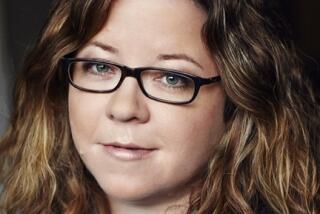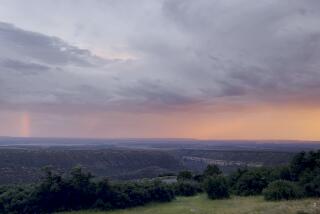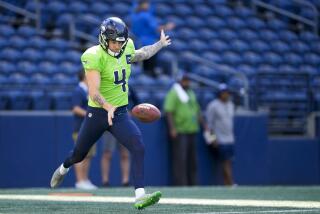Australia’s Vast Outback: Distance Is the Common Bond
TAMBO, Australia — In this uncommon land where swans are black, trees shed bark instead of leaves and it has rained fish, the common denominator is distance.
Eye-stretching, boot-scraping, camel-trekking, jet-spanning, habit-forming, isolation-producing, economics-determining, politics-shaping, culture-defining distance.
“G’day, Miss Alix,” says a second-grader to his teacher. Miss Alix is 346 miles away in a radio booth.
An aborigine is speared in a tribal dispute. Les Bushell of the Royal Flying Doctor Service in Alice Springs sends a medical plane on a 250-mile flight to treat him.
1,900 Miles to Darwin
A trucker towing two big trailers has been on the road for 30 hours, straight from Brisbane to the next meaningful city to the west, Darwin. He isn’t there yet. It’s 1,900 miles.
In January, two youths in a mandatory four-wheel drive trucklet set off from the Kimberleys in the northwest to cross three deserts to Melbourne, 1,700 miles away. Neither they nor their vehicle have been seen since.
Some people on Outback cattle stations have never seen a traffic light or the oceans that ring this island continent.
A Long Driveway
Greig and Eve Francis drive hundreds of miles daily out of Tambo in central Queensland, he delivering fuel, she the mail. Greig Francis used to be a head stockman on a cattle ranch--a “property”--of 5,500 square miles, somewhat smaller than Connecticut and Rhode Island combined. The road into the main spread equals the distance from New York to Philadelphia.
There is a property in South Australia of 15,000 square miles, the size of Switzerland. It used to be 17,000 square miles--1 1/2 Belgiums, before two Luxembourgs were sold off.
John and Alexander Forrest left the west coast of Australia in 1874 to follow their aborigine guides gingerly from water hole to water hole. The 1,800-mile trek took six months.
In 1880, Nat Buchanan became justly famous for driving 20,000 head of cattle to Darwin from the Outback. The trip covered 2,000 miles.
Sparse Population
Much of what Australia is, and isn’t, is a result of distance. In an area the size of the 48 contiguous United States, there are only 16 million people, six states, the Canberra capital district and Darwin’s northern territory. The states used to charge import duties on each other’s products. Years ago they laid rails of different widths because no one thought there would ever be a need for a national railroad. In February, the last stretch of the 1,600-mile highway from Adelaide on the south coast to Darwin was paved.
Distance brought the white man to Australia in 1788. London, 11,000 miles away, wanted a far penal colony to dump hard-core convicts, and a Pacific base against European rivals.
Colonization began in Sydney and spread along the southeast coast in widely separated port sites--Brisbane, Melbourne, Hobart and Adelaide, the only one founded by free settlers. Eighty percent of Australians live in this coastal strip, shaped like a beer drinker’s working arm.
The concentration is partly the result of distance. The authorities did not want their convict charges seeking freedom in the Outback, which was, and remains, thinly settled.
Wool Factory
Distance helped make Australia the wool factory that it is. Bullock-carted wheat could not pay the economic freight to reach a world market. It was too bulky. But wool could.
Britain set land prices inordinately high for new immigrants in the 19th Century, further dictating coastal cluster. Immigrants paid 80 times what new Americans paid for land after the U.S. Homestead Act of 1862.
Many of the immigrants were English urbanites. The loneliness of the bush daunted them. It still does. They stuck to the coast.
Repeated gold strikes opened up widely scattered parts of the Outback. Railroads fingered out from coastal hubs. But they didn’t connect the coastal cities. No one thought there was a need to connect the far-flung ports. There was no national railroad of common width until 1960.
Convict Forefathers
Eighty percent of Australians descend from the 160,000 founding convicts--once a matter for shame, now of pride--or free immigrants from Ireland and the British Isles. With subtle differences, they speak the same tongue.
There are descendants of Afghan camel drivers from frontier days, Italian and Portuguese fishermen, Chinese coolies of the gold rushes, World War II displaced persons. But this is not yet a melting pot of the American type. Distance made it far easier and cheaper to reach America than Australia. Northern Australia once wanted to import Asian labor. The distant south said no and had the votes. So Australia stayed white and was distant enough to largely remain so.
Aussies call Western Australians “sand gropers,” South Australians “crow eaters,” Queenslanders “banana benders.” But they share an intense nationalism, heightened perhaps by their isolation from the mainstreams of their Western origins. Some call this “cultural cringe,” an overcompensated sense of inferiority.
The isolation of distance gave the Outback a macho emphasis. In 1851 the Outback numbered only 69 women per 100 males. Sheep and cattle stations were a man’s world.
Disdain for Authority
In a convict environment, says Prof. Geoffrey Blainey of Melbourne in his history “Tyranny of Distance,” Australians developed a disdain of authority even as government--the jailers--played a dominant role, confining their charges to towns where they could be more easily supervised.
Vestiges of that attitude remain, even in an immense land, where Darwin is closer to Singapore than to Melbourne and Perth is closer to Jakarta than to Sydney.
Much of Central Australia is red desert and scrub, a land that looks as if it had been left out in the sun to rust. Seventy percent of it can’t be cultivated. Evaporation exceeds the rainfall.
The Outback includes Inback, a day from a coast, Halfback, Wayback and Throwback, Stone Age terrain where ancestors of Australia’s 180,000 remaining aborigines have led their spear and boomerang nomadic life for perhaps 100,000 years.
6 Hours to Tambo
Greig Francis has a fuel business in Tambo, a town of 400 that lies six hours of hard driving from Brisbane down a bumpy road laid out by U.S. Army engineers during World War II. His oil truck once was trapped in the mud--”bogged”--for four days.
“The cab never looked so clean,” he said.
When it’s dry, Tambo countryside is scrubby. When the “wet” comes, it is crew-cut Kansas grassland.
Francis sees distance as a factor in the mind-set of the far-flung property owners he services over thousands of square miles. Francis is a graduate of Agricultural College.
‘The Local Aristocracy’
“The sheep men could get 120 lambs per 100 ewes if they’d change their way of breeding, as they do in New Zealand,” Francis said. “But they’re satisfied with doing it the way their fathers did.
“They’re the local aristocracy, but they’re very provincial. Go to their parties, and if you argue politics, you’ll be talking to the wall. The men talk about blowflies and rams, the women about children.
“When I was working at Chatsworth (the 5,500-square-mile cattle ranch far to the west of Tambo), all the decisions came from the head office in Brisbane. You weren’t allowed to think for yourself. For years, cattle stations ranged English-type cattle because that’s what the English owners knew.
“They said we should slaughter after three years. It wasn’t until Australian stockmen became owners that it was accepted that English breeds did not do as well here and that a bullock needed seven years of grazing.”
‘Convict Mentality’
Distance in miles, distance in time.
“There’s a convict mentality,” Francis said. “People don’t like being told what to do.”
Distance of history.
The other day, Greig’s wife, Eve, set out in a four-wheel-drive recreation vehicle on one of her mail routes. Daughter Megan, almost 3, chirped brightly in her car seat. Behind Megan was a load of junk mail, letters, bills, newspapers from the outside world, two five-gallon drums of sheep dip, a bale of wool bales, a case of goat-branding dye, some eggs and a new vacuum cleaner for the Sandersons.
Mud, Dust and Sheep
Eve drove for eight hours through rolling grassland, unforgiving red mulga hardscrabble, tire-deep mud, dust and a herd of sheep. She just missed bashing a dashing kangaroo; passed two ostrich-like emus; had tea with Kim Davidson overlooking a new swimming pool; waved to the Bucknells’ pet koala bear, a creature that resembled Alfred Einstein zonked out in a eucalyptus tree; lunched by a cattle watering hole; worried that a battleship-gray curtain of rain across a yellow prairie would bog the car, and chatted with schoolchildren who had waded armpit-deep across a flooded creek to reach Barney Lewis’ schoolbus just starting out on its daily 175-mile rounds.
In an area where everyone is at least known to everyone else for 400 miles around, Eve carries more mail than gossip.
At a property called Erclidune, Eve stashed the mail in a rusting old refrigerator--the house was nine miles up a driveway--and worried about red-backed spiders, the Australian black widows, inside.
Windmill Pumps Repaired
She dropped off mail for Jack Carroll, 90, who stopped off 56 years ago on the way from somewhere to somewhere else to fix a steam engine. He stayed on to make a career fixing the many windmill pumps that make this area viable.
At the end of the day, she and Megan had covered 149 miles to deliver to 19 properties. She has to drive 40 miles just to reach another of her routes, a 140-mile dirt circuit.
Megan didn’t cry once.
Simon Conway told his school class in Alice Springs the other day what he’d been doing.
“Last Wednesday the men went camel-catching,” he said. “Uncle Rob fell off his motorbike and dad took him into town.”
School by Radio
Simon’s 140 schoolmates come from such places as Argadargada, Curung, Banka Banka, Renner Springs and Rabbit Flat, which is 338 miles from the schoolhouse in Alice Springs.
They all go to class by two-way radio. They see each other and their teachers twice a year at get-togethers in Alice Springs. The rest of the time, until a proposed satellite puts it all on TV, they are daily voices on a radio.
“You have to get used to the idea that a microphone is a child,” said Kim Davidson, who used to be a school-of-the-air teaching supervisor.
Australia has 12 such schools to serve the Outback. The first was established in Alice Springs in 1951 when some radios had to be powered by a pedaled generator. Each pupil is given a 10-day course, which he finishes at his own speed with help from mom or a paid teacher on the cattle station. Papers and tests are sent in by mail to be graded. Once a year the teacher visits the student in person, either by four-wheel-drive vehicle or plane.
‘A Support System’
“You get to see the student in his own environment and meet the parents,” Miss Alix, a second-grade teacher, said. “This is really a support system.
“For secondary school, most parents send the kids to boarding school. Academically, they’re very well prepared.
“But they all have social problems. They live in an adult world and are not really used to behaving as children. If they want attention at home on the station, or the road camp or the track road stop, they get it. At boarding school, they have to wait their turn. Some come into school cringing in the back of the car.”
They are learning the heartbreak of distance.
Most will eventually go back to the Outback. It’s the life they know.
A Harsher School
The Outback itself is a harsher school. It teaches survival or else. If a sign says, “Next water 200 miles,” believe it. Carry your own. If your vehicle dies, stay with it. An aboriginal tracker and a family of five died of thirst less than two miles from a water well last year because they didn’t. Check in at every roadhouse or cattle station and call back when you’ve reached the next one.
This is a Martian landscape of unrelieved red, where cattle ranches are huge because they have to be to support enough steers to make a living, where at Marble Bar in Western Australia it once was more than 100 degrees for 160 days in a row. You can drive for hours or days without a sign of humans, not even a thin telephone wire hung from scraggly tree trunks dug into the rocky ground.
From such land comes much of the mineral wealth that makes Australia an important source of the world’s raw materials.
Luck plays a part of survival. The wet has been good lately in parts of Queensland. But Cunnamulla in the southern region has had one inch of rain since 1985.
Flying Doctors
When a chainsaw slips into a leg, when a horse or a tractor throws its rider, when an aborigine clubs another with a bludgeon called a nulla-nulla for stealing one of his wives, survival takes the form of the Royal Flying Doctor Service. The base in Alice Springs, one of 14 throughout Outback Australia, serves an area larger than the length of Britain. It has three planes, five pilots and six doctors available so that no accident victim or diabetic or cardiac case is more than two hours from medical care.
“We brought 1,000 cases into Alice last year,” dispatcher Les Bushell said.
Word comes in from the 150 cattle stations in the vast area or from aboriginal outposts.
“Our pilots have no ground navigational aids,” Bushell said. “They have to contend with dust storms and summer thermals and still know one hill from another.”
Stones or Rags
At the average station airstrip, marked with whitewashed stones or burning kerosene-soaked rags at night, there may be 20 whites--the Aussie cowboys or “ringers” (they circle the cows to round them up), the owner and his wife, maybe a governess-teacher for the kids, a cook, a hand who does nothing but repair windmills, a fence mender. On larger stations, like Chatsworth, there may be an accountant.
It is true Marlboro Country, where it’s best not to ask too many questions, where manhood is tested on a monthly Saturday night in the nearest town at a tavern. A land of boots, saddles and wide-brimmed akubra hats--”the wider the brim, the smaller the property.”
Time becomes a measure of distance. Chatsworth still depended on animal transport when Greig Francis first came there in 1969.
Ringers muster cattle with helicopters now on some stations.
Smart Cattle
It worked at first. “But the cattle are learning to hide under trees,” Francis said.
The Queensland coast is Wetback: tropical, mountains, beach resorts, the submerged coral rainbows of the Great Barrier Reef.
Cairns, a resort aborning where the poured cement of high-rise hotels is hardly dry with more to come, calls itself the Gateway of the Far North. It is three hours by jet from Sydney--Los Angeles to Seattle. But you could fly another hour up the York Peninsula and still be in Australia.
Distance has been conquered to Cairns by hardtop road. The cassowary, a flightless bird of the rain forest with a bony keel atop its head to crash through the undergrowth, is a victim of such a victory. Eight have been killed by cars this year on the highway below Cairns.
You can drive on paved road for another 60 miles along the beach-scalloped coast to Daintree. But then the pavement ends and the rain forest--and distance--take over again.
About 200 yards from the end of the pavement down a gravel path to the Daintree River is a sign nailed to a tree:
“Beware of crocodiles.”
More to Read
Sign up for Essential California
The most important California stories and recommendations in your inbox every morning.
You may occasionally receive promotional content from the Los Angeles Times.










